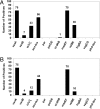Toxin-antitoxin systems are ubiquitous and plasmid-encoded in vancomycin-resistant enterococci
- PMID: 17190821
- PMCID: PMC1765457
- DOI: 10.1073/pnas.0601168104
Toxin-antitoxin systems are ubiquitous and plasmid-encoded in vancomycin-resistant enterococci
Abstract
Vancomycin-resistant enterococci (VRE) are common hospital pathogens that are resistant to most major classes of antibiotics. The incidence of VRE is increasing rapidly, to the point where over one-quarter of enterococcal infections in intensive care units are now resistant to vancomycin. The exact mechanism by which VRE maintains its plasmid-encoded resistance genes is ill-defined, and novel targets for the treatment of VRE are lacking. In an effort to identify novel protein targets for the treatment of VRE infections, we probed the plasmids obtained from 75 VRE isolates for the presence of toxin-antitoxin (TA) gene systems. Remarkably, genes for one particular TA pair, the mazEF system (originally identified on the Escherichia coli chromosome), were present on plasmids from 75/75 (100%) of the isolates. Furthermore, mazEF was on the same plasmid as vanA in the vast majority of cases (>90%). Plasmid stability tests and RT-PCR raise the possibility that this plasmid-encoded mazEF is indeed functional in enterococci. Given this ubiquity of mazEF in VRE and the deleterious activity of the MazF toxin, disruption of mazEF with pharmacological agents is an attractive strategy for tailored antimicrobial therapy.
Conflict of interest statement
The authors declare no conflict of interest.
Figures




Similar articles
-
A continuous fluorometric assay for the assessment of MazF ribonuclease activity.Anal Biochem. 2007 Dec 15;371(2):173-83. doi: 10.1016/j.ab.2007.07.017. Epub 2007 Jul 26. Anal Biochem. 2007. PMID: 17706586 Free PMC article.
-
Novel vancomycin-resistance transposon, plasmid replicon types, and virulence factors of vancomycin-resistant Enterococci in Zhejiang, China.Microb Drug Resist. 2012 Apr;18(2):183-8. doi: 10.1089/mdr.2011.0140. Epub 2012 Jan 18. Microb Drug Resist. 2012. PMID: 22257297
-
Antibiotic activity against urinary tract infection (UTI) isolates of vancomycin-resistant enterococci (VRE): results from the 2002 North American Vancomycin Resistant Enterococci Susceptibility Study (NAVRESS).J Antimicrob Chemother. 2003 Sep;52(3):382-8. doi: 10.1093/jac/dkg352. Epub 2003 Jul 29. J Antimicrob Chemother. 2003. PMID: 12888592
-
[Vancomycin resistant enterococcal infections and detection of their resistance genes].Rinsho Byori. 2002 Nov;Suppl 123:62-70. Rinsho Byori. 2002. PMID: 12652792 Review. Japanese.
-
Problems and perils of vancomycin resistant enterococci.Braz J Infect Dis. 2000 Feb;4(1):9-14. Braz J Infect Dis. 2000. PMID: 10950627 Review.
Cited by
-
Comparative analysis of the first complete Enterococcus faecium genome.J Bacteriol. 2012 May;194(9):2334-41. doi: 10.1128/JB.00259-12. Epub 2012 Feb 24. J Bacteriol. 2012. PMID: 22366422 Free PMC article.
-
Emerging Roles of Toxin-Antitoxin Modules in Bacterial Pathogenesis.Molecules. 2016 Jun 17;21(6):790. doi: 10.3390/molecules21060790. Molecules. 2016. PMID: 27322231 Free PMC article. Review.
-
Enterococci in river Ganga surface waters: propensity of species distribution, dissemination of antimicrobial-resistance and virulence-markers among species along landscape.BMC Microbiol. 2009 Jul 18;9:140. doi: 10.1186/1471-2180-9-140. BMC Microbiol. 2009. PMID: 19615089 Free PMC article.
-
Enterococcus faecalis: implications for host health.World J Microbiol Biotechnol. 2024 May 4;40(6):190. doi: 10.1007/s11274-024-04007-w. World J Microbiol Biotechnol. 2024. PMID: 38702495 Review.
-
Population structure and acquisition of the vanB resistance determinant in German clinical isolates of Enterococcus faecium ST192.Sci Rep. 2016 Feb 23;6:21847. doi: 10.1038/srep21847. Sci Rep. 2016. PMID: 26902259 Free PMC article.
References
-
- Richards MJ, Edwards JR, Culver DH, Gaynes RP. Infect Control Hosp Epidemiol. 2000;21:510–515. - PubMed
-
- Shepard BD, Gilmore MS. Microbes Infect. 2002;4:215–224. - PubMed
-
- Koch S, Hufnagel M, Huebner J. Exp Opin Biol Ther. 2004;4:1519–1531. - PubMed
-
- Wisplinghoff H, Bischoff T, Tallent SM, Seifert H, Wenzel RP, Edmond MB. Clin Infect Dis. 2004;39:309–317. - PubMed
Publication types
MeSH terms
Substances
Grants and funding
LinkOut - more resources
Full Text Sources
Other Literature Sources

